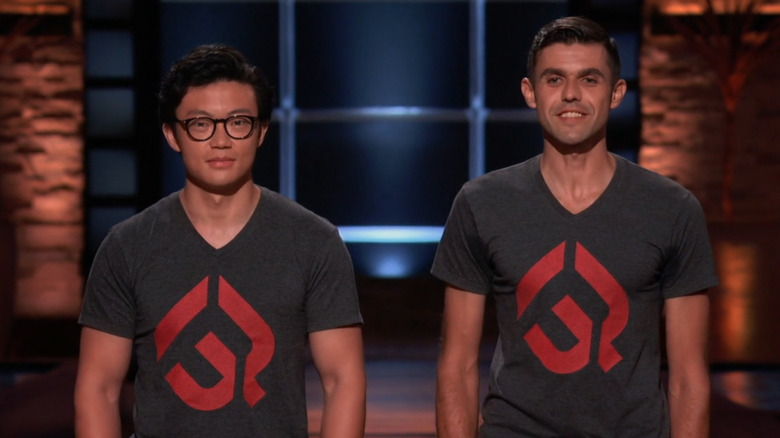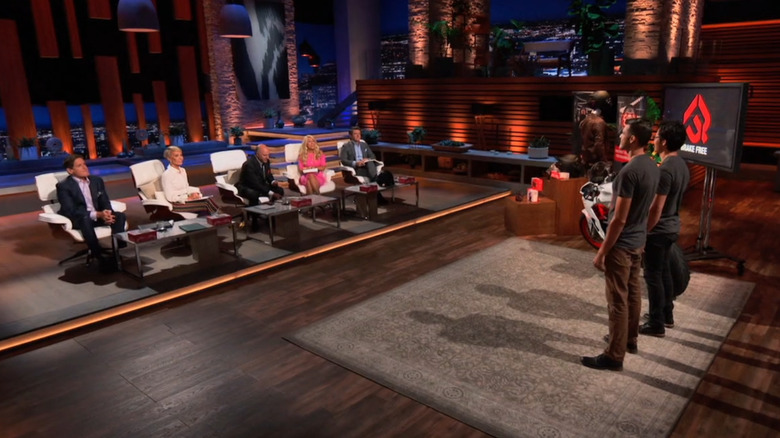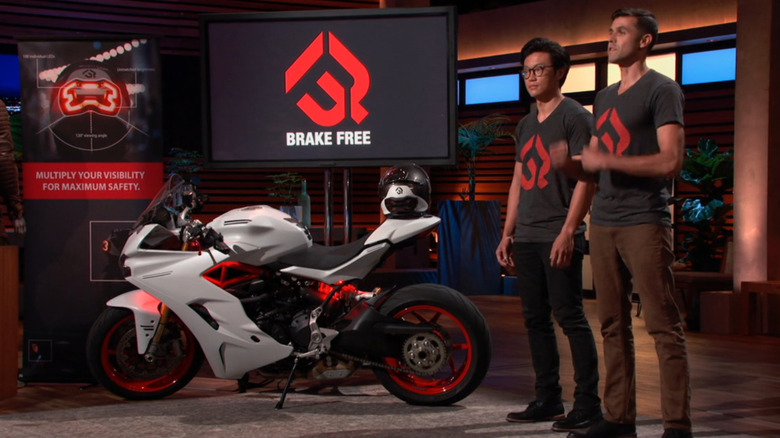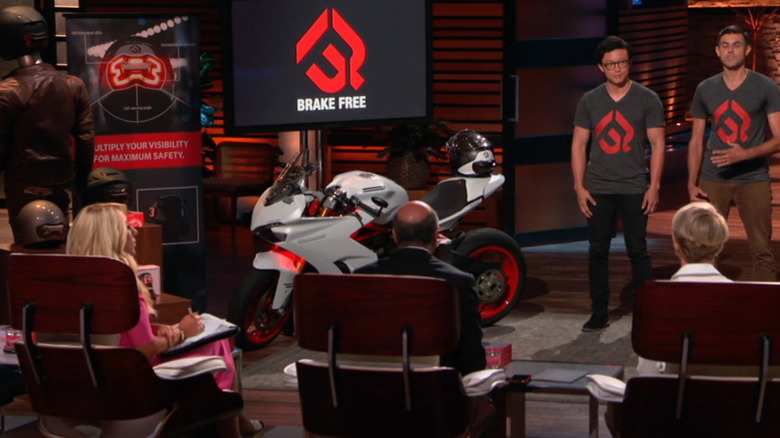What Happened To Brake Free From Shark Tank Season 12
Though many enjoy the thrill and excitement of riding motorcycles, there comes with these vehicles plenty of safety concerns that stem from the relative exposure of the rider. While cars and trucks protect drivers and passengers, those riding on motorcycles don't have such liberties. Gone are seat belts and the rigid frames of cars and trucks and instead motorcycle riders have at best a helmet, a neck brace, and an airbag vest. As noted by the National Safety Council, motorcycles only account for 3% of vehicles on the road, but make up 14% of the accidents and 17% of fatalities.
Considering this grim fact, it seems that several motorcycle riders and entrepreneurs have taken it upon themselves to try and think up interesting solutions to this problem. Popping up on a season 12 episode of the popular reality television show "Shark Tank," Brake Free is a device that attaches to the back of a motorcycle helmet that features an array of bright LED lights, though what made these Brake Free lights so unique is that they're programmable with different settings, and even capable of displaying when a motorcycle rider is breaking — and all without wires, cables, or applications. So what happened to Brake Free on "Shark Tank," and how has the product fared since its appearance?
What happened to Brake Free on Shark Tank?
Appearing on Season 12's Episode 8, Brake Free was presented by two of the company's founders, Henry Li and Alex Arkhangelskiy. Ian Dunn, Trevor Leger, and Johan Boot, the other three co-founders of the company, were absent from the episode. Arkhangelskiy started the pitch, explaining how much fun riding motorcycles can be, but noting how dangerous the act is. Arkhangelskiy added that he has a family and two children, which is part of the reason why he and his partners created Brake-Free. The first impression of the "Shark Tank" investors was amazement, though many of them had some apprehension in biting at Brake-Free's request for $200,000 in funding in return for a 10% equity in the company.
Immediately, the investors of "Shark Tank" confessed that Brake Free is a great idea, and asked questions about how the device works and whether or not Brake Free has a patent. Explaining that the Brake-Free costs $169.99, uses the same kind of sensors to track movement as smartphones, and that Brake-Free does indeed have a patent, the Brake Free presenters were heartbroken when Kevin O'Leary, Barbara Corcoran, and Lori Greiner declined Brake Free's offer. Luckily, Robert Herjavec was willing to provide the requested $200,000, but he wanted 20% equity. At this point in the episode, Mark Cuban also expressed interest in the company, which eventually resulted in both Herjavec and Cuban working together, and Brake Free accepting the deal for $200,000 and 20% equity.
How did Brake Free do after its Shark Tank appearance?
Before Brake Free's appearance on "Shark Tank," the company managed to scare up $259,797 in funding on IndieGoGo in 2017. Founded in 2014, Brake Free's episode on "Shark Tank" premiered in December 2020, and it seems as if Brake Free's appearance on the hit series certainly helped the company grow. In the aftermath of the show, Brake Free's co-founder Henry Li posted on LinkedIn, "2020 has truly been an unprecedented year on so many levels. Full of ups and downs and surprises. I am grateful to have my health and my job but also grateful for the opportunity to share with everyone the personal project I have been working on for the past few years." Li added, "It was an amazing opportunity and I am filled with gratitude to everyone who has supported Brake Free and myself along the way."
By June 2021, Brake Free's growth exploded, and it was reported that the company had already accrued 7,000 sales worth a total of $1.1 million. This certainly highlights that Brake Free was buoyed by the infamous "Shark Tank" effect, which basically means that the company being put into the national spotlight resulted in a tremendous uptick in sales.
Is Brake Free still in business?
Considering the outcome of Brake Free's appearance on "Shark Tank," it should come as no surprise that the company is still very much in business and as popular as ever. Brake Free's projected sales for 2021 were $3 million, and by January 2023, Brake Free had sales in excess of $3.9 million. As of April 2023, Brake Free had an estimated net worth of $2.6 million. These numbers surely paint a positive picture, and Brake Free appears to be trending upwards year after year.
Checking out Brake Free's website, you can see that not only is Brake Free thriving, it appears to be having issues keeping up with demand. As of July 2023, it's prominently displayed that if you are interested in the Brake Free array of helmet lights, you'll have to pre-order and wait for the device to arrive. However, the website points out that pre-orders should be sent out by the end of July, so it isn't like the company is completely buried in demand; it's simply waiting on production and manufacturing. Still, this is a fantastic problem to have, and it shows that Brake Free could grow even more in order to keep up with extroardinary demand.
What's next for Brake Free?
So, what kind of plans does Brake Free have for the future? As of the time of this writing, Brake Free hopes to continue to expand its operations, since the company currently only ships to Canada and the United States. However, Brake Free has an ambition to expand these shipping options to countries beyond North America, so it's only a matter of time before you see the exceptionally bright LED helmet lights adorning motorcycles in Europe and beyond. When Brake Free is finally able to achieve this goal, the company has stated that it will make an announcement on its social media channels and newsletter. However, although Brake Free doesn't offer European shipping orders on their main website, it does have an alternate website for international customers as a stop-gap measure, but the company says that this process is much more time-consuming and requires manual inputs.
With Brake Free's current ascension and yearly growth, chances are the company will continue to expand its operations, and hopefully be able to handle the enormous customer demand. Beyond the patented Brake Free helmet accessory, Brake Free also has different products that are currently available, such as extra helmet mounts of varying sizes. At the end of the day, though, Brake Free's bread and butter is the Brake Free helmet add-on, and it will be interesting to see if the company is able to continue to rise.




